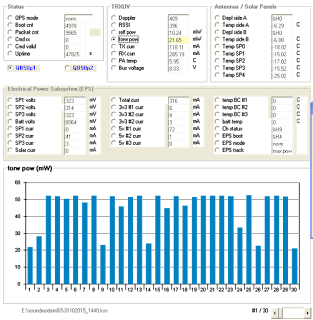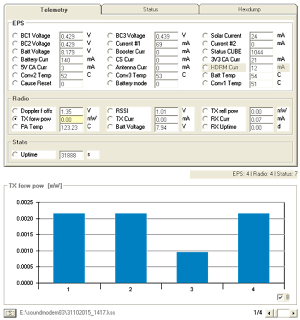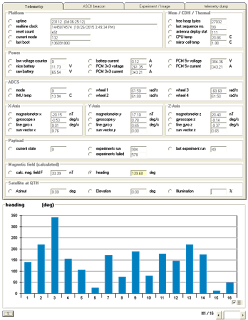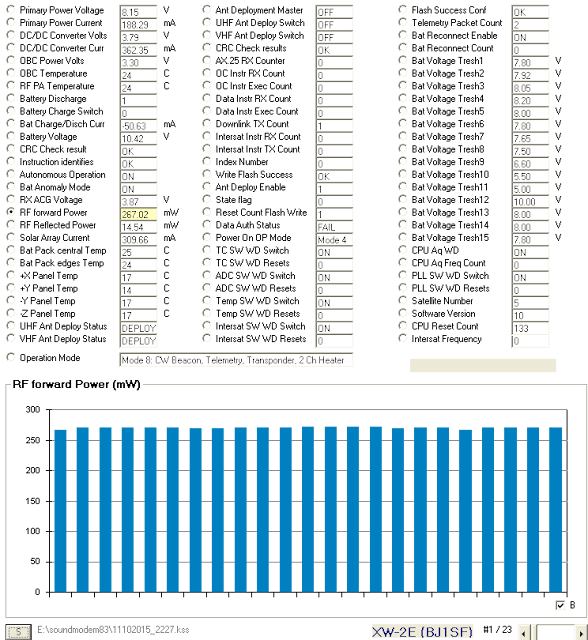
Home » Archives for October 2015
Super Strypi (SPARK)
● Argus, EDSN, HawaiiSat-1, ORS-Squared, PrintSat, STACEM, STU-1, Supernova-Beta --------------------------------------------------------------------------------------------Super Strypi/SPARK, (C)Sandia National Lab. Launch of these satellites is planned on 1 or 2 Nov. Pacific Missile Range - Kokole Point, Kauai, Hawaii http://spaceflight101.com/spacerockets/spark-super-strypi/
Argus Saint Louis University, USA 437.290MHz 1200bps AFSK, 2403.000-2403.400MHz Spread spectrum http://space.skyrocket.de/doc_sdat/argus.htm
EDSN Edison Demonstration of Smallsat Networks, Santa Clara University, USA 437.100MHz 1200bps AFSK, 2401.200-2431.200MHz http://directory.eoportal.org/web/eoportal/satellite-missions/e/edsn http://www.nasa.gov/directorates/spacetech/small_spacecraft/edsn.html
HawaiiSat-1 (HiakaSat-1) University of Hawaii Uplinks and Downlinks on both VHF and UHF, 9600bps GFSK High speed S Band downlink using High Rate Telemetry Downlink: Data Rate: 1.5Mbps Modulation: QPSK FEC: Viterbi r=1/2,k=7 ITU Emission http://www.hsfl.hawaii.edu/wordpress/missions-2/hawaiisat-1/
ORS-Squared COSMIAC at the University, New Mexico 437.325MHz 9600bps GMSK http://cosmiac.org/space-missions/ors-squared/
PrintSat Montana State University, USA 437.325MHz 9600bps GMSK http://amsat-uk.org/2012/06/08/printsat-an-amateur-radio-3d-printer-cubesat/
STACEM Space Dynamics Laboratory / Utah State University, USA 3U CubeSat, 4 deployable fixed solar arrays, batteries http://www.spacedynamics.org/
STU-1 ShanghaiTech University, China 436.360MHz 9600bps GMSK, 2402.000-2445.000MHz http://www.hsfl.hawaii.edu/HSFL_missions.html
Supernova-Beta Pumpkin Inc, USA 437.570MHz, 1200bps AFSK, 6U http://www.cubesatkit.com/docs/SUPERNOVA_User_Manual-RevA0.pdf http://www.cubesatkit.com/docs/SUPERNOVA%28TM%29_6U_BLOCK_III_ICD.PDF
(C)Hawaii Space Flight Lab. Satellite Downlink Beacon Mode ---------------------- ----------------- ------- ------------ Argus 2403.000-2403.400 437.290 1200bps AFSK EDSN 2401.200-2431.200 437.100 1200bps AFSK HawaiiSat1 (HiakaSat1) 145.9805 437.2705 9600bps GFSK ORS-Squared 437.325 . 9600bps GMSK PrintSat 437.325 . 9600bps GMSK STACEM . . ? STU-1 2402.000-2445.000 436.360 9600bps GMSK Supernova-Beta 437.570 . 1200bps AFSK ---------------------- ----------------- ------- ------------
SOURCE JE9PEL/1
HiakaSat Beacon
UPDATE 2015-10-27:
The launch date has slipped. Possible launch dates now are Nov 1 or 2.
The beacon will transmit every 15 seconds on both UHF and VHF frequencies.
- Spacecraft Name: HiakaSat
- Target Launch Date: Nov 1 or 2
- Orbit: 415x490km, 94.7 degrees, Period of 93.6 minutes
- UHF Beacon: 437.2705MHz (437.26-437.28 MHz), 9600bps GFSK 2W
- VHF Beacon: 145.9805MHz (145.97-145.99 MHz), 9600bps GFSK 1W
- Baseline Receive Equipment:
- Ham Radio IC-9100 or IC-7000, ‘Data 2’ Port 9600bps FSK Output
- MixW Software TNC in packet mode w/ VHF 9600bps defaults and TNC emulation, or Kantronics TNC using 9600bps FSK port
HawaiiSat-1
Thermal Hyper-Spectral Remote Sensing Mission
One of the first design iterations of HawaiiSat-1’s satellite
UPDATE 2015-10-27:
The launch date has slipped. Possible launch dates now are Nov 1 or 2.
UPDATE 2015-10-26:
Please visit this page for more information on the orbit and beacon frequencies for HiakaSat:
http://www.hsfl.hawaii.edu/wordpress/missions/hawaiisat-1/hiakasat-beacon/
The HawaiiSat-1 mission aims to
demonstrate the Hawai`i Space Flight Laboratory’s ability to design,
launch, and operate satellites. This supports the Office of Responsive
Space (ORS) office activities, as well as supports research objectives
of the University of Hawaii. The Hawai`iSat-1 mission includes a 55kg
(~121 lbs) low-Earth orbiting satellite, named ‘HiakaSat’, which will be
the platform for demonstrating a DARPA-funded UH-developed long wave
infrared hyper-spectral imaging system. In addition, the satellite will
be outfitted with two color cameras to provide wide and narrow view
images of the Earth.
Objectives
The HawaiiSat-1 mission aims to achieve the following objectives:
» Demonstrate a cost effective on-orbit platform for performing technology demonstrations» Perform remote sensing with the newly designed space ultra-compact hyper-spectral imager (SUCHI)
» Perform imaging with two HSFL color cameras which are co-aligned with SUCHI
» Provide workforce development opportunities for students and recent graduates
» Further develop infrastructure for sustainable satellite development, integration and test, and operations
Workforce Development
Incorporating the efforts from UH
students as early as 2003, this mission is the evolution of the largest
satellite workforce development effort that HSFL and the Hawaii Space
Grant Consortium have jointly taken on. The underlying philosophy has
been to “build the team to run the missions”. From the time this mission
concept was launched in 2009, over 30 students and interns were
directly involved in the design and fabrication of the spacecraft
itself, as well as more than 20 additional UH students who worked on
supporting projects to analyze and test spacecraft components. Many of
our students have since graduated, and have become an important part of
our post-graduate workforce development fellowship programs.
Hyper-Spectral Imaging Payload
Developed by the Hawaii Institute of
Geophysics and Planetology, SUCHI’s hyper-spectral imaging
technology produces images like the one shown here. Each pixel from the
SUCHI payload will contain over 250 data points to create a series of
infrared intensities for wavelengths between 8.5 to 13 microns.
Information from the intensity versus wavelength can be used to identify
materials, and specific wavelengths can reveal what can’t be seen by
the naked eye. This important demonstration will validate this exciting
new hyper-spectral imaging technology for future missions.
UKube-1 CubeSat Completes Mission
UKube-1, the UK Space Agency’s first national spacecraft, has now
completed its nominal mission following over 14 months of operations.
Discussion is underway with AMSAT-UK about the possibility of taking
over UKube-1 operations to continue its educational and outreach
activities.
Launched in July 2014, UKube-1 is a technology demonstration mission with a broad set of objectives aimed at attracting and training future generations of engineers, encouraging collaboration across sectors and institutions, fast tracking space technology development and engaging with students.
As a 3 unit CubeSat (30x30x10cm), flying 4 main payloads, with all the key subsystems of much larger satellites, UKube-1 remains one of the most advanced CubeSats ever built. Despite some technical challenges in orbit, the mission has achieved a range of milestones including:
• delivery into the correct planned orbit (around 650km, sun-synchronous)
• successful deployment of solar panels and antenna
• good battery health
• slow spin rate measured
• uplink and downlink capabilities checked, including Large Data Transfer, downlink at 3 speeds, and redundant communications mode
• all core payloads commissioned and data collected for each
• on-board camera technology successfully tested
• data downlinked from multiple ground stations across the globe
UKube-1 has also helped maintain the UK’s leading position in the CubeSat sector. Participation in the mission placed Clyde Space in an excellent position to capitalise on the fast growing global nanosatellite market. The company has experienced 100% year on year growth, both in turnover and employees, as a direct result from involvement in UKube-1, and is firmly established as a global leader.
Mark McCrum, Bright Ascension Ltd, said:
“UKube-1 provided us with an invaluable opportunity to gain flight heritage for our software technology and to get deeply involved in the operation of a complex CubeSat mission. It gave a huge boost to our credibility as a space software provider and has been instrumental in winning further work.”
Craig Clark, CEO Clyde Space Ltd, said:
“UKube-1 represents a pivotal achievement in the development and growth of Clyde Space. The project moved the company from being a spacecraft subsystems supplier to providing full missions for our customers. To give some context to the extent that Ukube-1 has had to our business, Clyde Space has more than quadrupled in size in the last 3 years and there are currently over 60 CubeSats planned through production here in Glasgow over the next 18 months. The return on investment for Ukube-1 in terms of jobs and export sales for the UK has been outstanding and is a great example of industry and the UK Space Agency working together to put the UK at the forefront of global space technology.”
Professor Andrew Holland, Open University, added:
“Involvement in the UKube-1 mission, though our C3D instrument, has had a positive effect on our research and technology programme within the Space Instrumentation Group at the Open University, as well as a positive effect on our technology partners in the project; XCAM Ltd and e2v Ltd. The project has helped the OU to build a new strand of instrument development within the group, raised awareness of the CubeSat platform as a potential vehicle to accelerate the development of scientific space instrumentation, and has provided early in-orbit-demonstration of technologies. The mission introduced us to new academic and industrial collaborators operating in the space sector and supported the career development of the young engineers and scientists working on the project.”
STFC’s RAL Space provided the Ground Station for the misison at Chilbolton Observatory in Hampshire UK, and UKube-1 operations were commanded from there. Mission Manager Dr Helen Walker said:
“It has been a very exciting time, made possible only with the great support from all the teams involved.”
Although the Agency-supported mission phase has ended, discussion is underway with AMSAT-UK about the possibility of taking over UKube-1 operations to continue its educational and outreach activities until the satellite orbit naturally degrades.
More information about UKube-1 can be found in the missions section of the UK Space Agency website https://www.gov.uk/government/case-studies/ukube-1
Source https://www.gov.uk/government/news/ukube-1-completes-mission
UKube-1 carries a set of AMSAT-UK FUNcube boards which provide an educational beacon for use by schools and a linear transponder for amateur radio communications.
UKube-1 nominal frequencies:
• 145.840 MHz Telemetry downlink
• 145.915 MHz FUNcube subsystem beacon
• 400 mW inverting SSB/CW linear transponder
– 435.080-435.060 MHz Uplink
– 145.930-145.950 MHz Downlink
Dr Helen Walker gave a presentation on UKube-1 to the 2015 AMSAT-UK International Space Colloquium in Guildford.
Source: http://amsat-uk.org
Launched in July 2014, UKube-1 is a technology demonstration mission with a broad set of objectives aimed at attracting and training future generations of engineers, encouraging collaboration across sectors and institutions, fast tracking space technology development and engaging with students.
As a 3 unit CubeSat (30x30x10cm), flying 4 main payloads, with all the key subsystems of much larger satellites, UKube-1 remains one of the most advanced CubeSats ever built. Despite some technical challenges in orbit, the mission has achieved a range of milestones including:
• delivery into the correct planned orbit (around 650km, sun-synchronous)
• successful deployment of solar panels and antenna
• good battery health
• slow spin rate measured
• uplink and downlink capabilities checked, including Large Data Transfer, downlink at 3 speeds, and redundant communications mode
• all core payloads commissioned and data collected for each
• on-board camera technology successfully tested
• data downlinked from multiple ground stations across the globe
UKube-1 has also helped maintain the UK’s leading position in the CubeSat sector. Participation in the mission placed Clyde Space in an excellent position to capitalise on the fast growing global nanosatellite market. The company has experienced 100% year on year growth, both in turnover and employees, as a direct result from involvement in UKube-1, and is firmly established as a global leader.
Mark McCrum, Bright Ascension Ltd, said:
“UKube-1 provided us with an invaluable opportunity to gain flight heritage for our software technology and to get deeply involved in the operation of a complex CubeSat mission. It gave a huge boost to our credibility as a space software provider and has been instrumental in winning further work.”
Craig Clark, CEO Clyde Space Ltd, said:
“UKube-1 represents a pivotal achievement in the development and growth of Clyde Space. The project moved the company from being a spacecraft subsystems supplier to providing full missions for our customers. To give some context to the extent that Ukube-1 has had to our business, Clyde Space has more than quadrupled in size in the last 3 years and there are currently over 60 CubeSats planned through production here in Glasgow over the next 18 months. The return on investment for Ukube-1 in terms of jobs and export sales for the UK has been outstanding and is a great example of industry and the UK Space Agency working together to put the UK at the forefront of global space technology.”
Professor Andrew Holland, Open University, added:
“Involvement in the UKube-1 mission, though our C3D instrument, has had a positive effect on our research and technology programme within the Space Instrumentation Group at the Open University, as well as a positive effect on our technology partners in the project; XCAM Ltd and e2v Ltd. The project has helped the OU to build a new strand of instrument development within the group, raised awareness of the CubeSat platform as a potential vehicle to accelerate the development of scientific space instrumentation, and has provided early in-orbit-demonstration of technologies. The mission introduced us to new academic and industrial collaborators operating in the space sector and supported the career development of the young engineers and scientists working on the project.”
STFC’s RAL Space provided the Ground Station for the misison at Chilbolton Observatory in Hampshire UK, and UKube-1 operations were commanded from there. Mission Manager Dr Helen Walker said:
“It has been a very exciting time, made possible only with the great support from all the teams involved.”
Although the Agency-supported mission phase has ended, discussion is underway with AMSAT-UK about the possibility of taking over UKube-1 operations to continue its educational and outreach activities until the satellite orbit naturally degrades.
More information about UKube-1 can be found in the missions section of the UK Space Agency website https://www.gov.uk/government/case-studies/ukube-1
Source https://www.gov.uk/government/news/ukube-1-completes-mission
UKube-1 carries a set of AMSAT-UK FUNcube boards which provide an educational beacon for use by schools and a linear transponder for amateur radio communications.
UKube-1 nominal frequencies:
• 145.840 MHz Telemetry downlink
• 145.915 MHz FUNcube subsystem beacon
• 400 mW inverting SSB/CW linear transponder
– 435.080-435.060 MHz Uplink
– 145.930-145.950 MHz Downlink
Dr Helen Walker gave a presentation on UKube-1 to the 2015 AMSAT-UK International Space Colloquium in Guildford.
Watch UKube-1: technology, mission and operations – Dr Helen Walker
UKube-1 http://amsat-uk.org/satellites/communications/ukube-1/Source: http://amsat-uk.org
PSAT-1
PSAT-1]APOFF,ARISS,qAR,YC3BVG:s#010601,0z290,CFaf0dfFcfGbeHacH0AH0EGbFFeGDfF0fFdg
PSAT-1]APOFF,ARISS,qAR,YC3BVG:T#632,879,073,890,630,834,00011100
PSAT-1]APOFF,ARISS,qAR,YC3BVG:s#010600,0z290,f0dfbddbedbeeade0deDceFcdFccFb0FbCEc
PSAT-1]APOFF,ARISS,qAR,YC3BVG:T#631,876,071,896,628,835,00011100
PSAT-1]APOFF,ARISS,qAR,YC3BVG:T#632,879,073,890,630,834,00011100
PSAT-1]APOFF,ARISS,qAR,YC3BVG:s#010600,0z290,f0dfbddbedbeeade0deDceFcdFccFb0FbCEc
PSAT-1]APOFF,ARISS,qAR,YC3BVG:T#631,876,071,896,628,835,00011100
PSAT-1

1:Fm PSAT-1 To APOFF Via ARISS <UI R Pid=F0 Len=50> [01:03:25R]
!20 . S\133 . ES090/999/W3ADO s#007257,0z290
1:Fm PSAT-1 To APOFF Via ARISS <UI R Pid=F0 Len=34> [01:05:32R]
T#720,795,073,957,848,807,00011100
1:Fm PSAT-1 To APOFF Via ARISS <UI R Pid=F0 Len=52> [01:06:34R]
s#007259,0z290,000000000000000000000000000000000000
1:Fm PSAT-1 To APOFF Via ARISS <UI R Pid=F0 Len=34> [01:07:34R]
T#722,793,085,959,854,810,00011100
1:Fm PSAT-1 To APOFF Via ARISS <UI R Pid=F0 Len=50> [01:08:08R]
!29 . S\139 . ES090/999/W3ADO s#007260,0z290
1:Fm PSAT-1 To APOFF Via ARISS <UI R Pid=F0 Len=34> [01:08:35R]
T#723,793,071,960,857,811,00011100
1:Fm PSAT-1 To APOFF Via ARISS <UI R Pid=F0 Len=34> [01:09:36R]
T#724,780,347,961,861,813,00011100
1:Fm PSAT-1 To APOFF Via ARISS <UI R Pid=F0 Len=50> [01:09:41R]
!32 . S\142 . ES090/999/W3ADO s#007261,0z290
!20 . S\133 . ES090/999/W3ADO s#007257,0z290
1:Fm PSAT-1 To APOFF Via ARISS <UI R Pid=F0 Len=34> [01:05:32R]
T#720,795,073,957,848,807,00011100
1:Fm PSAT-1 To APOFF Via ARISS <UI R Pid=F0 Len=52> [01:06:34R]
s#007259,0z290,000000000000000000000000000000000000
1:Fm PSAT-1 To APOFF Via ARISS <UI R Pid=F0 Len=34> [01:07:34R]
T#722,793,085,959,854,810,00011100
1:Fm PSAT-1 To APOFF Via ARISS <UI R Pid=F0 Len=50> [01:08:08R]
!29 . S\139 . ES090/999/W3ADO s#007260,0z290
1:Fm PSAT-1 To APOFF Via ARISS <UI R Pid=F0 Len=34> [01:08:35R]
T#723,793,071,960,857,811,00011100
1:Fm PSAT-1 To APOFF Via ARISS <UI R Pid=F0 Len=34> [01:09:36R]
T#724,780,347,961,861,813,00011100
1:Fm PSAT-1 To APOFF Via ARISS <UI R Pid=F0 Len=50> [01:09:41R]
!32 . S\142 . ES090/999/W3ADO s#007261,0z290
Subscribe to:
Posts (Atom)Template Responsive Design































































